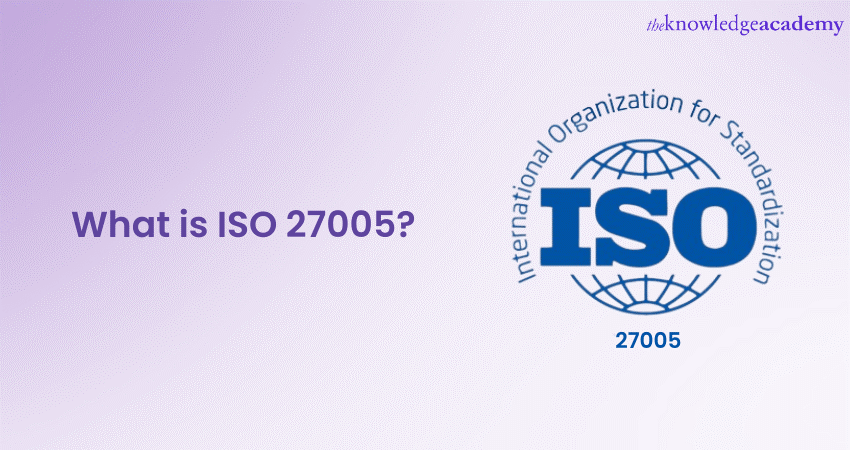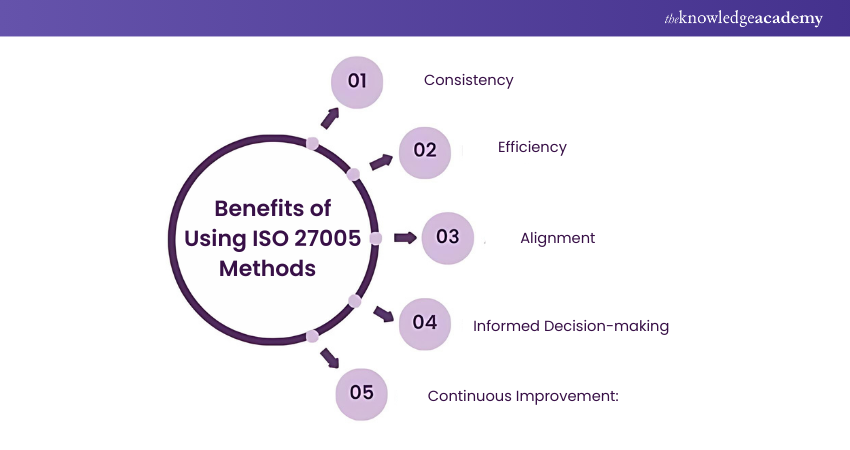We may not have the course you’re looking for. If you enquire or give us a call on +357 26030221 and speak to our training experts, we may still be able to help with your training requirements.
We ensure quality, budget-alignment, and timely delivery by our expert instructors.

How can businesses protect their data from growing cyber threats? A robust Risk Management strategy is crucial. One such framework is ISO 27005, which offers clear guidelines to find, assess, and effectively manage security risks. Understanding What is ISO 27005 and how it works can help companies strengthen their Cyber Security measures and protect information. In this blog, we will discuss ISO 27005, its key principles and its benefits in managing information security risks.
Table of Contents
1) What is ISO 27005?
2) The Framework of ISO 27005
3) What is Information Security Risk Management?
4) The Six Key Components of the ISO 27005 Risk Management Process
5) Benefits of Using ISO 27005 Methods
6) Challenges and Best Practices of Implementing ISO 27005
7) What is the Scope and Purpose of ISO 27005?
8) Why Should Organisations Adopt ISO 27005?
9) Conclusion
What is ISO 27005?
ISO 27005 is an international standard that gives information on how to conduct Information security risk assessments in accordance with ISO 27001. Risk assessments are highly important when it comes to implementing ISO 27001, as they show the identification, treatment, and control of Information security risks and the implementation of relevant controls sourced from Annex A.
Key Points:
a) Subset of broader best practices for preventing data breaches.
b) Guidance on identifying, assessing, evaluating, and treating information security vulnerabilities.
c) Central to ISO27k ISMS for rational planning, execution, administration, monitoring, and management of security controls.
d) Ensure effective management of information security risks.
e) No clear compliance path, just recommended best practices adaptable to any standard.
The Framework of ISO 27005
Here are the key parts of the ISO 27005 framework:

a) Helps businesses identify, assess, and manage security risks
b) Supports companies in choosing the best ways to handle risks
c) Helps find possible threats to information security
d) Analyses how serious and likely each risk is
e) Suggests ways to reduce, avoid, or control risks
f) Requires regular reviews and updates to stay secure
g) Works alongside ISO 27001 to improve security management
h) Useful for small and large companies in any industry
What is Information Security Risk Management?
Information Security Risk Management is the process of finding, assessing, and reducing risks that could harm a company’s data. It helps businesses protect important information from cyber threats, hacking, and data loss. By following a structured approach, companies can identify weak points and take steps to keep their data safe. This process is important for preventing security breaches and protecting customer trust.
Key Points:
a) Identifies risks that could lead to data breaches or cyberattacks
b) Assesses the impact of risks and how likely they are to happen
c) Creates security measures to prevent or reduce risks
d) Monitors and updates security plans to stay protected
e) Ensures compliance with legal and industry security standards
Learn the importance of risk assessment with our ISO 27005 Lead Implementer Course – Join today!
The Six Key Components of the ISO 27005 Risk Management Process
ISO 27005 outlines a well-defined Risk Management process that is tailored to the field of Information Security. This process comprises the following key steps:
1) Context Establishment
This step helps businesses understand their security needs before managing risks. It involves identifying important information, threats, and security goals. By setting clear objectives, companies can create a strong Risk Management plan.
a) Defines the scope and security goals of the business
b) Helps identify potential threats to important data
c) Creates a clear plan for managing security risks
2) Risk Assessment
This step involves finding and analysing risks that could harm the company’s data. Businesses evaluate how serious each risk is and how likely it is to happen. This helps them prioritise which risks to handle first.
a) Identifies major risks to the organisation
b) Helps decide which risks need urgent action
c) Provides a structured way to evaluate security threats
3) Risk Treatment
In this step, businesses take action to reduce or control risks. They may fix weak points, improve security systems, or apply new safety measures. The goal is to prevent problems before they happen.
a) Reduces the impact of security risks
b) Strengthens existing security measures
c) Helps prevent future data breaches or cyberattacks
4) Risk Acceptance
Some risks cannot be fully removed, so businesses decide whether to accept them. If the cost of fixing a risk is too high, they might monitor it instead. Risk acceptance ensures resources are used wisely.
a) Avoids unnecessary spending on minor risks
b) Helps businesses focus on critical security threats
c) Ensures a balanced approach to Risk Management
5) Risk Communication and Consultation
This step involves sharing risk information with employees, management, and stakeholders. Everyone needs to understand the risks and security plans. Clear communication helps prevent misunderstandings and improves security awareness.
a) Ensures everyone knows their security responsibilities
b) Helps teams make better decisions about risks
c) Improves teamwork and awareness in security management
6) Risk Monitoring and Review
Security risks change over time, so businesses must regularly check and update their Risk Management plans. This step ensures that security measures remain effective. Companies must adapt to new threats and improve their defences.
a) Keeps security measures up to date
b) Helps identify new threats quickly
c) Ensures continuous improvement in Risk Management
Benefits of Using ISO 27005 Methods
Now that you are acquainted with the core components of ISO 27005, it’s time to explore how the advantages of this security standard can level up your Cyber Security game. Utilising ISO 27005 methods for information security Risk Management delivers numerous benefits, including the following:

1) Consistency:
a) Standardised approach ensures consistent and repeatable Risk Management processes.
b) Enhances predictability and reliability of Risk Management efforts.
2) Efficiency:
a) Structured framework streamlines risk assessments and treatment strategies.
b) Saves time and resources.
3) Alignment:
a) Aligns with ISO 27001, harmonising Risk Management with Information security Management practices.
b) Elevates overall effectiveness of an organisation’s security posture.
4) Informed Decision-making:
a) Systematic risk evaluation provides valuable insights.
b) Encourages judicious resource allocation and prioritisation of risk mitigation efforts.
5) Continuous Improvement:
a) Facilitates ongoing assessment and adaptation of security measures to evolving threats.
b) Ensures steady and strong organisational defences over time.
Learn to lead audit teams with our ISO 27005 Lead Auditor Training – Join today!
Challenges and Best Practices of Implementing ISO 27005
Implementing ISO 27005comes with significant challenges. It demands adherence to best practices to ensure successful integration into an organisation's Cybersecurity framework.
Challenges of Implementing ISO 27005
Some of the major challenges in implementing the ISO 27005 standard are as follows:
a) Lack of Leadership Support:
a) Strong leadership support is crucial for ISO 27005 implementation.
b) Without top management commitment, allocating necessary resources and fostering a culture of Information security awareness becomes difficult.
b) Resource Constraints: Many organisations face limited budgets and resources for Risk Management activities.
c) Complexity and Incompleteness of Risk Assessments: Conducting thorough risk assessments as per ISO 27005 can be complex and challenging.
d) Integration with Existing Processes: Integrating ISO 27005 with existing compliance requirements and business processes can be difficult.
e) Lack of Skilled Personnel: Skilled personnel are essential for successful ISO 27005 implementation.
Best Practices to Implement ISO 27005
Organisations can better protect their valuable assets and data by addressing common challenges and following the best practices outlined below:

a) Find possible threats to your data before they become serious problems
b) Check how likely each risk is and how much damage it could cause
c) Set clear steps to reduce or control risks effectively
d) Teach staff how to handle risks and protect company data
e) Regularly check and improve your security plan
f) Follow ISO 27005 and other rules to keep data
What is the Scope and Purpose of ISO 27005?
Here are the key points that explain the scope and purpose of it:
a) Helps businesses identify, assess, and manage security risks
b) Provides detailed steps to improve security within an ISO 27001 framework
c) Can be used by small and large companies in any industry
d) Helps businesses choose the best ways to handle security risks
Why Should Organisations Adopt ISO 27005?
Here are the reasons why businesses should use it:
a) Helps businesses keep customer and company data safe
b) Identifies threats early and prevents data breaches
c) Helps meet legal and industry security rules
d) Shows customers and partners that security is a top priority
Conclusion
We hope you now have a clear understanding of What is ISO 27005 and how it helps businesses manage security risks. This standard provides a structured way to identify and reduce threats to important data. By following ISO 27005, organisations can improve security, protect information, and stay compliant with industry standards. Using best practices ensures strong Risk Management and keeps businesses safe from cyber threats.
Learn strategies to improve security measures with our ISO 27005 Foundation Course – Join today!
Frequently Asked Questions
Why is ISO 27005 Important for an Organisation?

ISO 27005 helps develop the expertise you need to create a Risk Management process for Information Security. As such, it spotlights your capability for identifying, evaluating, and treating various Information Security threats that can impact your organisation.
How Does ISO 27005 Differ From Other ISO Standards Concerning Information Security?

ISO 27005 covers the following:
a) Provides explicit guidance for conducting Information Security risk assessments.
b) Ensures alignment with ISO 27001.
c) Offers methodologies and techniques for risk assessment.
d) Shares best practices for identifying and evaluating information security risks.
Other ISO Standards cover wider aspects of Information Security Management beyond risk assessment.
What Considerations Should Organisations Keep in Mind When Implementing ISO 27005?

The following considerations are important:
a) Expertise development
b) Information security threats identification
c) Threat evaluation
d) Threat treatment
e) Information security risk management capability
What are the Other Resources and Offers Provided by The Knowledge Academy?

The Knowledge Academy takes global learning to new heights, offering over 3,000 online courses across 490+ locations in 190+ countries. This expansive reach ensures accessibility and convenience for learners worldwide.
Alongside our diverse Online Course Catalogue, encompassing 19 major categories, we go the extra mile by providing a plethora of free educational Online Resources like News updates, Blogs, videos, webinars, and interview questions. Tailoring learning experiences further, professionals can maximise value with customisable Course Bundles of TKA.
What is The Knowledge Pass, and How Does it Work?

The Knowledge Academy’s Knowledge Pass, a prepaid voucher, adds another layer of flexibility, allowing course bookings over a 12-month period. Join us on a journey where education knows no bounds.
What are the Related ISO 27005 Courses and Blogs Provided by The Knowledge Academy?

The Knowledge Academy offers various ISO 27005 Courses, including ISO 27005 Foundation Course, ISO 27005 Lead Auditor Course and ISO 27005 Lead Implementer Course. These courses cater to different skill levels, providing comprehensive insights into Risk Retention and Risk Acceptance in ISO 27005.
Our IT Security and Data Protection Blogs cover a range of topics related to ISO 27005, offering valuable resources, best practices, and industry insights. Whether you are a beginner or looking to advance your IT Security and Data Protection skills, The Knowledge Academy's diverse courses and informative blogs have you covered.






 Top Rated Course
Top Rated Course




 If you wish to make any changes to your course, please
If you wish to make any changes to your course, please


